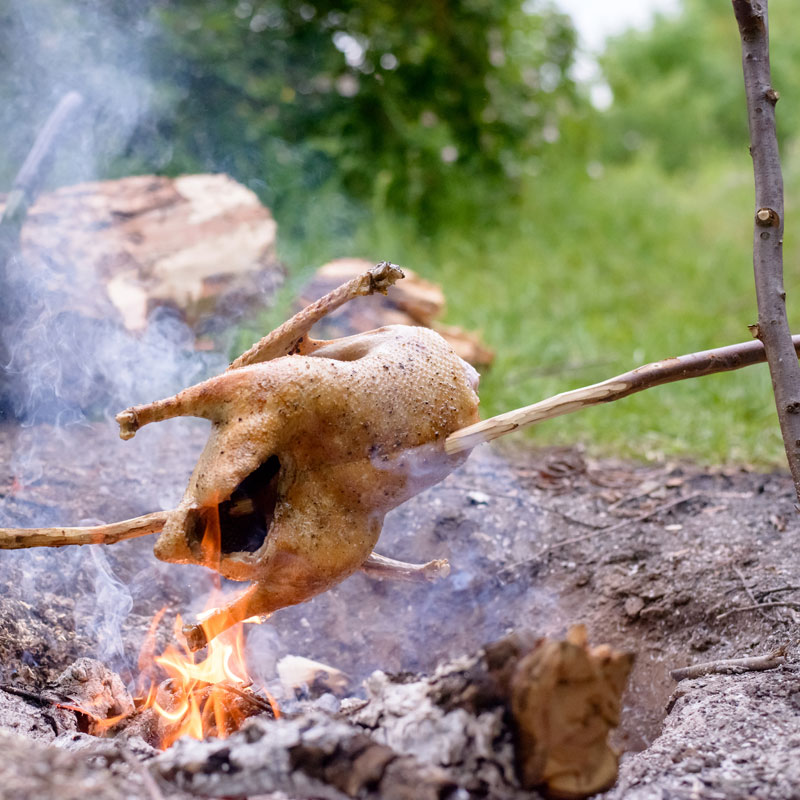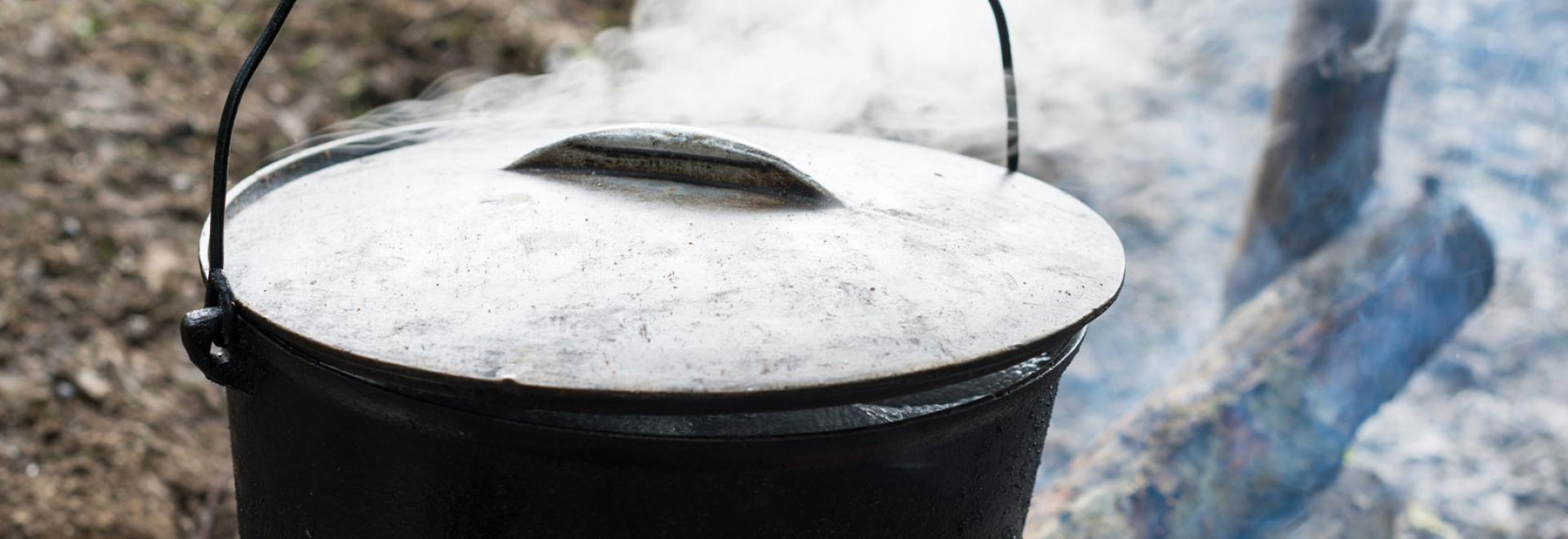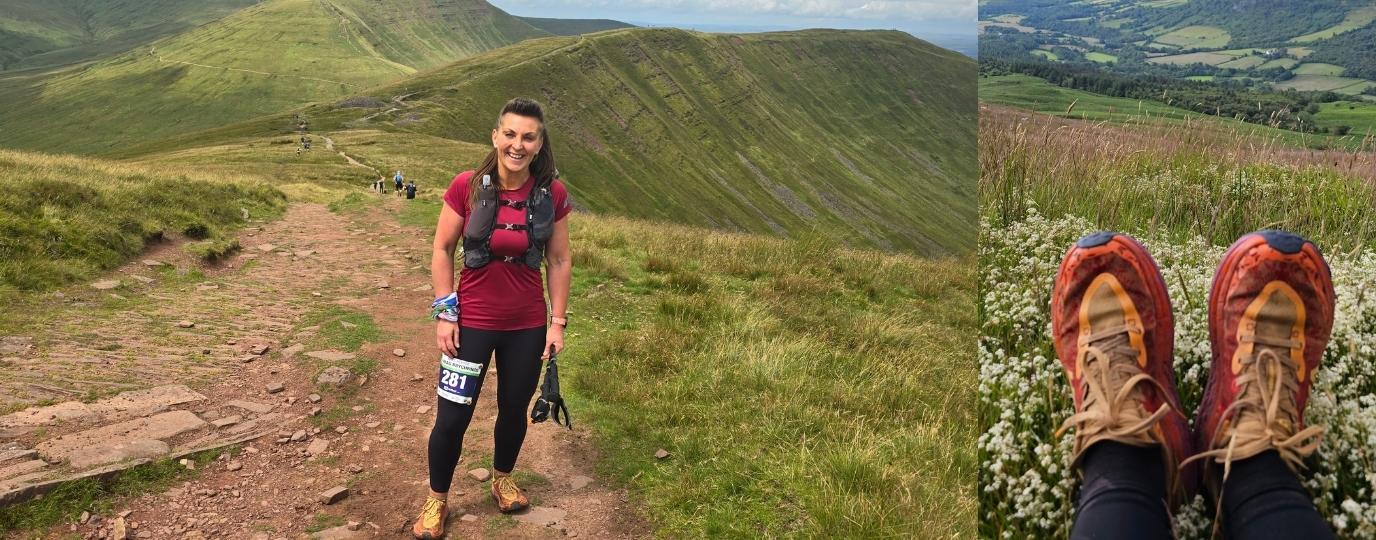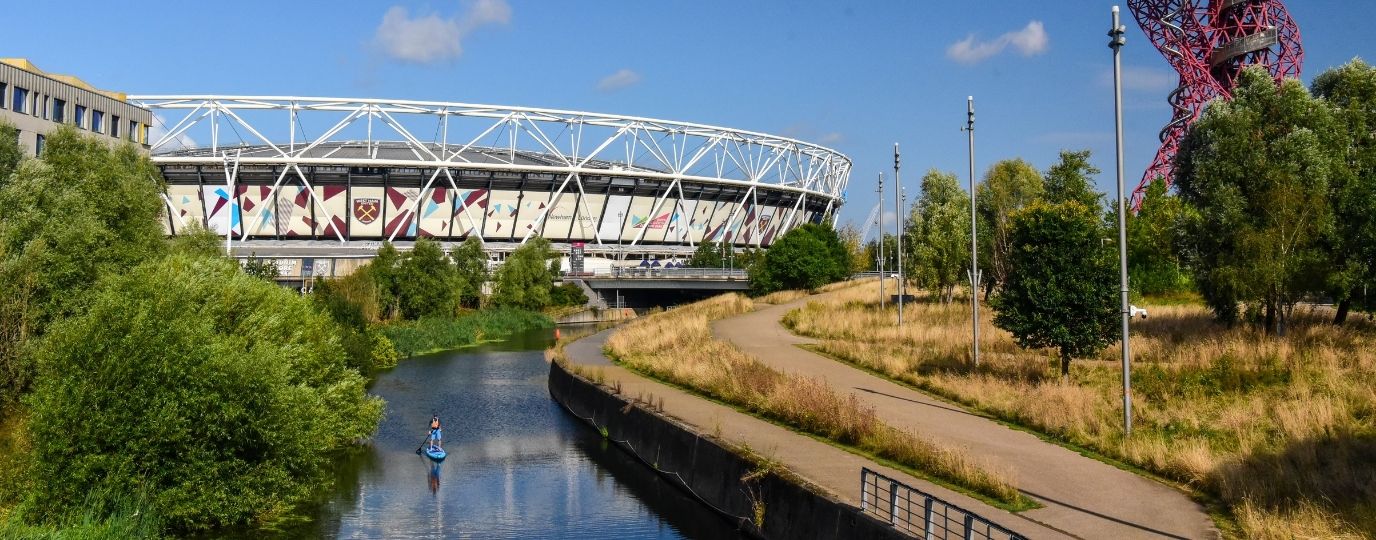With modern stoves, there’s not often a reason that you have to cook over a wood fire – but it’s great fun, even in your back garden. While gas or charcoal barbecues are the ‘civilised’ version, anyone can learn how to cook surprisingly complex dishes over an open fire.
Safety first!
Before we look at cooking, we need to look at safely having a fire in the first place. We’ve already covered some of this, so here’s the important bits:
- Make sure you are allowed fires. They are restricted in some places, such as camp sites and beaches. Generally you need the land owners permission
- Plan the fire in a place away from overhanging branches, dry grass or anything that may allow it to spread
- Keep the fire small enough to put out if needed, and if possible have water, sand or earth on hand to extinguish it.
- If you are wild camping, leave no trace of the fire. One way to do this it to carefully dig up a patch of sod, then replace it to hide the cold ashes, or to use an elevated fire pan to keep the fire off the ground
- Most kids love fires, but make sure they are aware of the risks – no running around with burning sticks or burning anything made of plastic
- Make sure a fire is fully extinguished before leaving. This means water, as just using earth can leave smouldering embers

Getting your fire going
If you are planning on cooking over a fire, fuel choice is more important than normal.
You want to use wood that does not smoke much, give a reasonable heat and burns slowly. Hardwoods such as oak, ash and beech are best for steady heat, as they burn for a long time. Softwoods such pine will burn faster and hotter, which is not ideal. They also contain more resins, which can create bitter scented smoke. Avoid any wood that is painted or has preservatives (green or orange coloured wood) as this could give off harmful chemicals.
The smoke from most hardwoods will add to the flavour. If you can find any fruit woods (such as apple) they can add a distinctive taste too. Whatever fuel you use, it needs to be dry to burn well and reduce smoke. If you are collecting wood locally (again, check local rules), choose wood that’s been dead for a while – it will feel relatively light. Alternatively petrol stations, country stores and other local shops often have sacks of ready-to-burn wood.
When lighting your fire, avoid the use of paraffin-based firelighters, lighter fluid or petrol – they’re going to taste nasty! You can get ‘natural’ lighters, or just use small tinder such as paper, straw, shavings or small twigs to get the fire going – see our beginners guide on lighting a fire.
Once the fire is going, you want it to burn down until there are few big flames. Like a barbecue, you generally cook over hot embers, so once it has reduced a little rake the embers to even them out. You can also pull some hot embers to the side, while keeping the main fire going.
Get cooking!
There’s lots of different ways to cook now you’ve got the fire going – here’s some of the best.
Frying pan
Use a heavy, cast iron frying pan or skillet, and cook in the same way as you would over a gas or electric ring. If you are lacking a frying pan, even a clean shovel or chunk of metal can do the trick. Deep sides will reduce the chances of fat spitting out or catching fire.
Be aware the whole pan, including the handle, is going to get really hot, so use a cloth, mitt or similar to pick it up.
Best for:
- Bacon and eggs
- Pancakes
- Burgers


Skewer (or a pointy stick)
Dead simple – a pointy stick. Poke the food on to one end, hold the other. Wood may burn itself, while metal skewers can get too hot to hold without a glove or cloth. Wearing an old glove (like a gardening glove) is a good idea to provide some protection.
This can be tricky to get right and patience is required, but advanced outdoor chefs can rig up something to hold the skewer for them.
Best for:
- Marshmallows
- Whole fish
- Dough (camp bread)
- Kebabs
- Sausages with bits of ash on
Grid or grill
Loads of different designs are available, but this is basically a big grid of metal that you place over the fire. They can stand on legs, or be suspended from a chain, and the better ones allow you to adjust the height.
The big advantage is more heat and smoke, adding to the flavour and allowing bigger things to be cooked, The downside is any fat can create flames. While a metal grill is best, for quick cooking items you can even improvise with damp green wood.
Best for:
- Burgers
- Steaks
- Sausages
- Chicken pieces


Spit
Basically a bigger skewer, this is a wooden or metal pole, held above the fire by a couple of supports. It’s perfectly possible to cook a whole chicken like this, but be aware it’s going to take a while – at least a couple of hours.
After browning, keep the spit well above the fire so no flames can reach it, as you will probably have to add new fuel, and remember to turn it regularly.
Best for:
- Whole chicken
- Joints of meat
- People who don’t mind waiting
Tinfoil
Simple, light and easy, you can cook almost anything wrapped in tinfoil. Just make sure it’s in the cooler embers towards the side – you can even rake a small amount out of a larger fire and start cooking earlier.
It will tend to burn a bit at the hottest parts, so some will use bread, cabbage leaves or similar inside the tinfoil to add additional protection. The tinfoil will also blacken completely, so remember to count how many you do!
Best for:
- Potatoes
- Sweetcorn
- Fish
- Baked apple


Cook pot or Dutch Oven
Dropped straight on an open fire or suspended above it, a good cook pot is able to help you make almost anything from hot water for tea to a warming stew after a hard days outdooring. Unlike most of these methods, you can cook directly on a flame, so can get started faster.
Ovenproof cast iron pans will work as cook pots. By changing the position you can get a hot fast cook to warm up a pre-packed meal, or a slow heat to cook a warming meal from scratch.
Don’t have a pot to hand? Tinfoil can be used to make a small pot – placed in not overly hot embers you can create remarkably well-done meals.
Best for:
- Stews
- Soups
- Boiling water
Open fire cooking problems
All the food is burnt on the outside, raw inside!
Lower the heat by moving foods towards the edge, higher up or by waiting longer before starting cooking. If you are doing slower-cooking foods in tinfoil, the bits on the outside do tend to get burnt. You can be clever by using things like whole cabbage leaves, flatbreads or similar to protect other foods.
I can’t get close enough to pick up the pans or hold skewers!
Your fire is probably too big. If you are just cooking one or two things, keep the fire small and neat – 30cm or so across. If you do have a larger fire, try to cook on a section of embers upwind from the main fire. Old gloves can be useful.
It’s taking too long!
Cooking will take longer – but that’s part of the appeal. Chop your foods up smaller, and use a grid for faster cooking. If you really won’t have time – cheat. You can cook some dishes in advance and just heat these up, while faster to cook items can be done there and then. You can buy pre-packed means that just need boiling and are great if you have been on the go all day and just need a quick hot meal.
I, umm, forgot the tinfoil…
Some things like potatoes and bananas can be cooked directly in the embers – just discard the skins. As an alternative (although I’ve never tried this) you can cook some foods, like fish, wrapped in leaves instead of tinfoil. By the time the leaves have dried out enough to burn, your dinner is cooked. You will probably need someone on hand who knows what local plants are safe to do this with – Kindling recommends hazel leaves.
Clearing up
If you have used an existing fire pit or a fire tray clearing up should be minimal, but if you’ve created a new fire spot you should generally try to minimise the impact:
- Make surge the fire is really, totally out, preferably by dousing in water
- If you collected stones spread them back out again
- Rake out or scatter the ashes to spread them
- Remove any bits of tinfoil, cans or anything that’s not wood ash and pack it in a rubbish bag for removal. Check you remove anything left over from part-burnt rubbish or dropped food
- If you lifted a section of turf, replace it over the fire pit – and give it a bit of water too
- Put any unused wood back in the area it was found, and scatter part-burned wood
There’s a great guide to clearing up a fire by Paul Kirtley here.
Have you got a great camp cooking tip or recipe? Tell us in the comments





